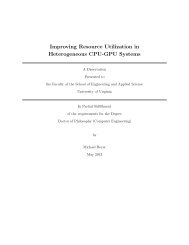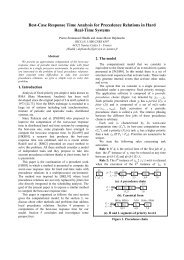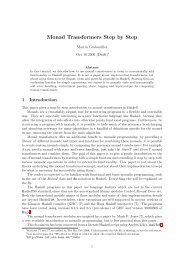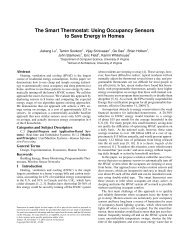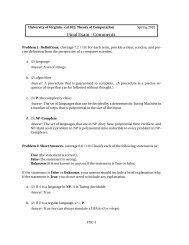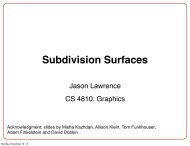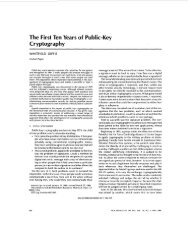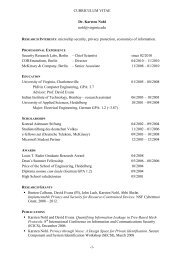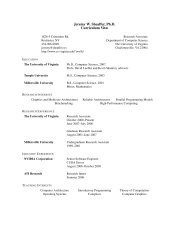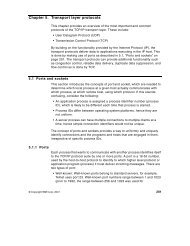Subroutines and Control Abstraction
Subroutines and Control Abstraction
Subroutines and Control Abstraction
Create successful ePaper yourself
Turn your PDF publications into a flip-book with our unique Google optimized e-Paper software.
174 Chapter 8 <strong>Subroutines</strong> <strong>and</strong> <strong>Control</strong> <strong>Abstraction</strong><br />
Direction<br />
of stack growth<br />
(lower addresses)<br />
sp<br />
fp (if used)<br />
Copyright c○ 2009 by Elsevier Inc. All rights reserved.<br />
8 bytes/64 bits<br />
Space to build<br />
argument lists<br />
Saved registers<br />
Local variables<br />
<strong>and</strong><br />
temporaries<br />
Arguments<br />
1<br />
n<br />
Current frame<br />
Previous (calling)<br />
frame<br />
Figure 8.10 Layout of the subroutine call stack for the SGI MIPSpro C compiler, running in<br />
64-bit mode. As in Figure 8.2, lower addresses are toward the top of the page.<br />
arguments are passed on the stack. Record arguments (structs) are implicitly<br />
divided into 64-bit “chunks,” each of which is passed as if it were an integer.<br />
A large struct may be passed partly in registers <strong>and</strong> partly on the stack.<br />
As noted in the main text, space is reserved in the stack for all arguments,<br />
whether passed in registers or not. In effect, each subroutine begins with some<br />
of its arguments already loaded into registers, <strong>and</strong> with “stale” values in memory.<br />
This is a normal state of affairs; optimizing compilers keep values in registers<br />
whenever possible. They “spill” values to memory when they run out of registers,<br />
or when there is a chance that the value in memory may be accessed directly (e.g.,<br />
through a pointer, a reference parameter, or the actions of a nested subroutine).<br />
The fp, if present, points at the first (top-most) argument.<br />
The argument build area at the top of the frame is designed to be large enough<br />
to hold the largest argument list that may be passed to any called routine. This<br />
convention may waste a bit of space in certain cases, but it means that arguments<br />
need not be “pushed” in the usual sense of the word: the sp does not change when<br />
they are placed into the stack.<br />
For languages with nested subroutines (C of course is not among them), MIPS<br />
compilers generally use register r2 to pass the static link. In all languages, registers<br />
r2 <strong>and</strong> f0 (depending on type) are used to return scalar values from functions.<br />
Values of type long double are returned in the register pair 〈f0, f2〉. Record<br />
values (structs) that will fit in 128 bits are returned in 〈r2, r3〉. For larger



